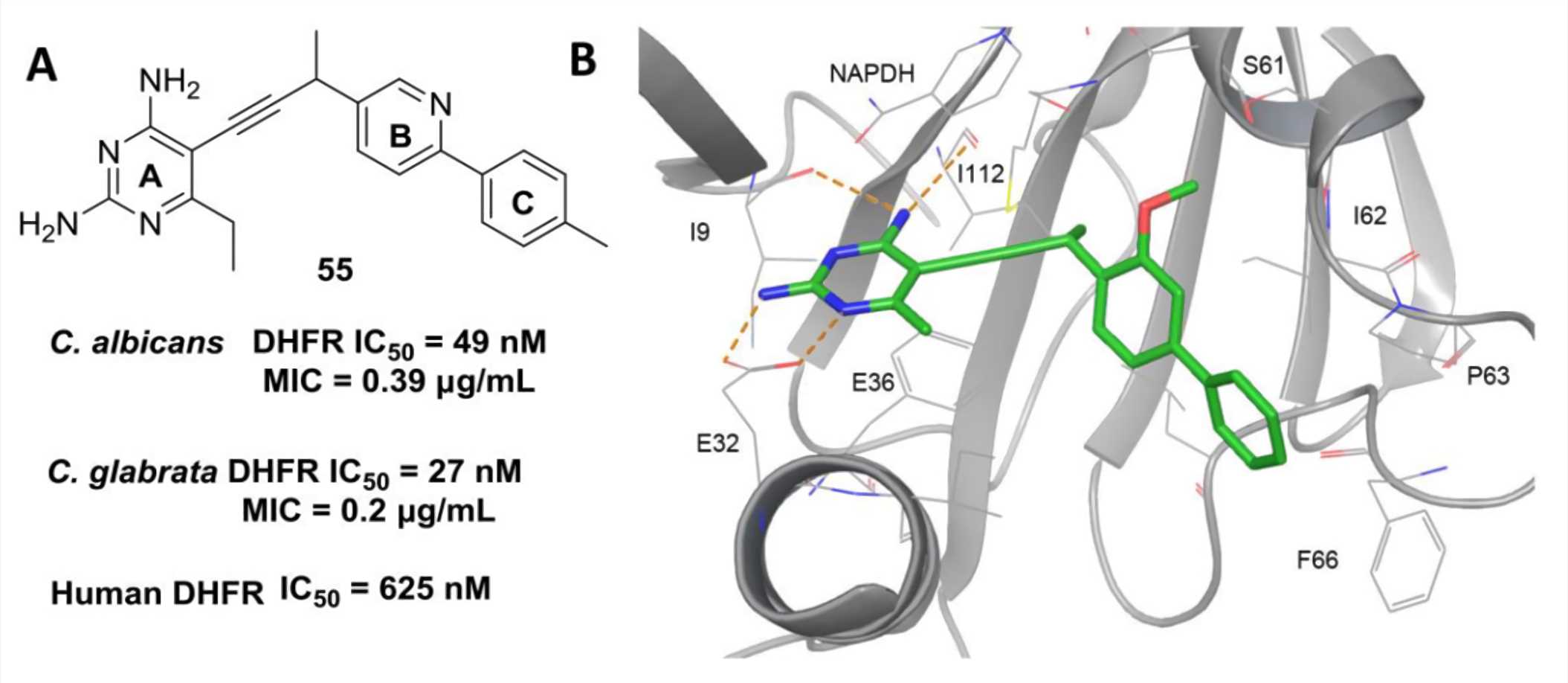Majority of clinically used antifungals suffer from various drawbacks in terms of toxicity, efficacy, and cost, and their frequent use has led to the emergence of resistant strains. Hence, there is a great demand for novel antifungals belonging to a wide range of structural classes, selectively acting on novel targets with fewer side effects. Here, we introduce the folic acid biosynthesis pathway as a potential target for novel antifungal drug development. Especially, dihydrofolate reductase (DHFR) provides an effective target to develop inhibitors with antifungal activity and enough selectivity.
Introduction of DHFR
DHFR is an enzyme that converts dihydrofolate into tetrahydrofolate in the folate biosynthetic pathway, playing a key role in the biosynthesis of purines, pyrimidines, and several amino acids. Effective inhibition of DHFR produces a blockade in thymidine synthesis leading to “thymineless” death. Clinically, inhibitors of DHFR have been used clinically as anticancer (e.g., methotrexate), antibacterial (e.g., trimethoprim), and antiprotozoal therapeutics for years. As DHFR is essential to all cells, inhibitors targeting pathogenic organisms must be selective as well as potent in order to avoid complications resulting from inhibiting the human enzyme.
 Fig.1 DHFR as a potential antifungal target. (A) Chemical structures and antifungal activity of fungal DHFR inhibitors. (B) Binding mode of a 2,4-diaminopyrimidine propargyl inhibitor with C. albicans DHFR (PDB 4HOF). (Liu, 2018)
Fig.1 DHFR as a potential antifungal target. (A) Chemical structures and antifungal activity of fungal DHFR inhibitors. (B) Binding mode of a 2,4-diaminopyrimidine propargyl inhibitor with C. albicans DHFR (PDB 4HOF). (Liu, 2018)
DHFR as an Antifungal Target
Studies have reported the essential enzyme, DHFR, as a potential target for inhibiting fungal infections. Based on structural biology studies, Liu et al. (2009) revealed that the differences in the active sites of DHFR between human and Candida species could be exploited to design selective inhibitors. They have found 2,4-Diaminopyrimidine propargyl derivatives potent DHFR inhibitors in Candida, with good selectivity over human DNFR. Moreover, by comparing the structural biology of the DNFRs between Candida glabrata and Candida albicans, they have laid the foundation of designing a potent inhibitor against both fungal enzymes. In summary, targeting GPI biosynthesis may offer considerable potential to develop novel, broad-spectrum antifungal therapeutics. In summary, targeting DHFR may offer considerable potential to develop novel, broad-spectrum antifungal therapeutics.
Features of Our Services
Development of antifungal agents remains an important priority in the pharmaceutical research industry. To promote new antifungal discovery, Creative Biolabs offers help in developing drugs with novel chemical structures and novel mechanism of action by providing a comprehensive portfolio of contract research services. Our services are characterized by:
-
Drug discovery against diverse potential targets and a broad range of fungal infections
-
Expert scientists and staff with keen project and program management skills
-
Robust, efficient processes combined with quality systems and on-time delivery of reports
-
Individualized technical support and best after-sale services
Creative Biolabs is a global integrated drug discovery partner for both the pharmaceutical and biotechnology industries. We can offer comprehensive support at every stage of the antifungal drug discovery process, covering target identification and validation, Hit identification, Hit to lead, Lead optimization, and IND enabling services. We can help you meet your drug discovery milestones while reducing the costs and timelines. For more information about our services, please do not hesitate to contact us.
References
-
Liu, J.; et al. Probing the active site of Candida glabrata dihydrofolate reductase with high-resolution crystal structures and the synthesis of new inhibitors. Chemical biology & drug design. 2009, 73(1): 62-74.
-
Paulsen, J. L.; et al. In vitro biological activity and structural analysis of 2, 4-diamino-5-(2’-arylpropargyl) pyrimidine inhibitors of Candida albicans. Bioorganic & medicinal chemistry. 2009, 17(14): 4866-4872.
-
Liu N.; et al. Emerging New Targets for the Treatment of Resistant Fungal Infections. Journal of Medicinal Chemistry. 2018.
For Research Use Only.


 Fig.1 DHFR as a potential antifungal target. (A) Chemical structures and antifungal activity of fungal DHFR inhibitors. (B) Binding mode of a 2,4-diaminopyrimidine propargyl inhibitor with C. albicans DHFR (PDB 4HOF). (Liu, 2018)
Fig.1 DHFR as a potential antifungal target. (A) Chemical structures and antifungal activity of fungal DHFR inhibitors. (B) Binding mode of a 2,4-diaminopyrimidine propargyl inhibitor with C. albicans DHFR (PDB 4HOF). (Liu, 2018)


